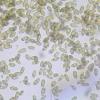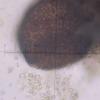
03-01-2026 13:08
Niek SchrierHi all,We found groups of perithecia on a Lecanora

29-12-2025 17:44
Isabelle CharissouBonjour,J'aimerais savoir si d'autres personnes au

01-01-2026 18:35
Original loamy soil aside a artificial lake.The co

31-12-2025 19:27
Collected from loamy soil, at waterside (completel

30-12-2025 16:44
Pascal DucosBonjour,Une anamorphe rose stipitée, très nombre

30-12-2025 17:14
 Bernard CLESSE
Bernard CLESSE
Bonjour à toutes et tous,Pourriez-vous aider Albe
We found groups of perithecia on a Lecanora/Myriolecis spec (probably Myriolecis dispersa) and can't find a name for it.
Host lichen was growing on basalt blocks near the waterline of a dyke. Perithecia mainly on the apothecia of the host. Conidia bigutate, ellipsoid sometimes with little deformations, measuring 7,5-8,5 x 3,0-3,5 ?m.
So far I considered the genus Unguiculariopsis, but dismissed it because of the lack of asci.
Does anyone have any suggestions? Thanks in advance.
Kind regards,
Niek and Tom Schrier
For more pics, see https://waarneming.nl/observation/382858810/

Mais je n'oublie pas tous les autres membres de ce forum, soyez tous en pleine forme cette année pour continuer de faire vivre l'étude des ascomycètes.
Meilleurs voeux à Ascofrance !
And ofcourse best wishes for 2026 (Alain aswell)!
Sorry for the confusion. We only saw pycnidia, so my search into Unguiculariopsis was not a smart move. But due to the fruiting bodies that looked to be on top of the apothecia, this Genus came to mind.
I took a look at Didymocyrtis and used the key in Ertz et al. 2015 (https://www.researchgate.net/publication/283945855), leading to D. bryonthae. That matches in conidia and protruding pycnidia, however it is only found on Lecanora epibryon (which looks to grow similar as the infected thallus we saw, but is a different species not found in the Netherlands). Are other hosts possible for bryonthae? Or could it be D. slaptoniensis? I only found slaptoniensis on
Xanthoria and Physcia.
Kind regards,
Niek







